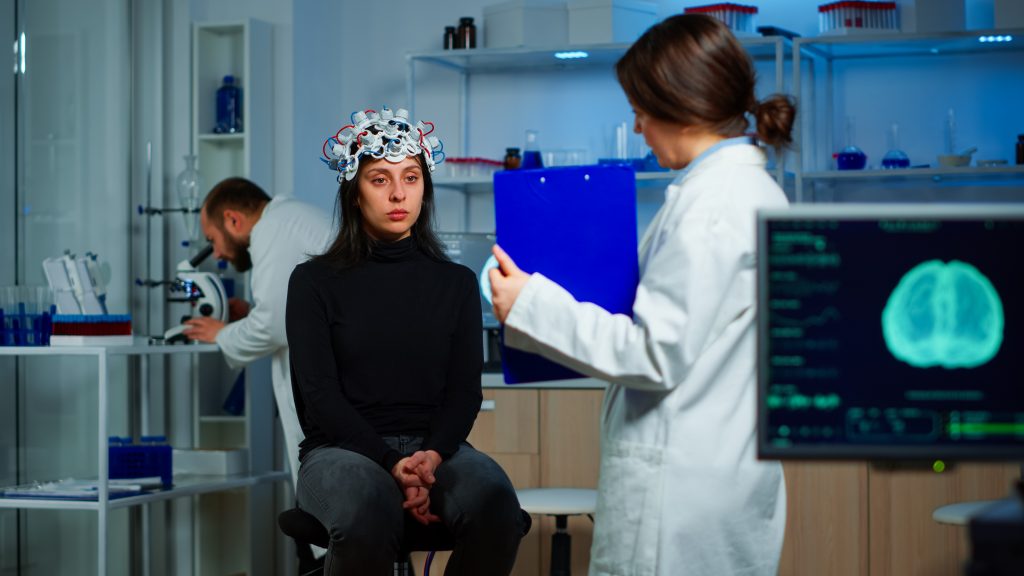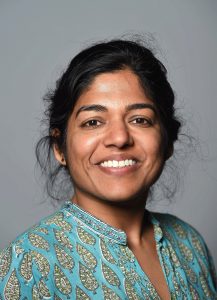Dr Jyoti Mishra – Neurotechnology for Cognitive Brain Mapping and Digital Therapeutics
Environmental factors and genetics both play a part in how our brains function, whether that be in a healthy or disordered manner. Understanding the processes by which mental health disorders arise is an important step in developing effective therapies. Dr Jyoti Mishra founded NEATLabs at the University of California, San Diego, to work towards this goal. Her exciting research is advancing cognitive brain mapping to investigate brain functions as well as novel digital therapeutics that are personalised to individual needs.
Brain Function and Dysfunction
Our brains are wonderfully complex organs that help us to navigate the world. Webs of neurons interact through electrical signals to provide us with sensory information, thoughts and emotions. However, when the normal processes in the brain become dysfunctional, concerns with mental health arise. Depending on a variety of factors such as which brain circuits or which area(s) of the brain are affected in specific dynamic patterns, different issues can develop. These conditions commonly manifest as depression, anxiety, post-traumatic stress disorder (PTSD) and attention deficit hyperactivity disorder in the general population.
Mental health disorders are on the rise, so uncovering the processes in the brain that cause them is essential to evolving new, effective therapeutics. Traumatic life events can play a role in brain dysfunction in many people, but the biological mechanisms behind them are still not completely understood.
Using innovative technology, Dr Jyoti Mishra is developing our knowledge surrounding this issue and pushing forward the field of neuroscience. Within the Department of Psychiatry at the University of California, San Diego, Dr Mishra founded the Neural Engineering and Translational Labs (NEATLabs). Here, she is the director of human research and works on improving neurotechnology for cognitive brain mapping (i.e., mapping of the brain dynamics underlying our cognitive abilities) as well as personalising digital mental health therapies to patients. Her research has highlighted how contextual influences and environments can alter brain development and normal function as well as how closed-loop technology is an exciting and promising opportunity to improve brain health.

The Brain Engagement Platform
At NEATLabs, Dr Mishra and her team recently developed a scalable, mobile platform called BrainE, which is short for Brain Engagement. This platform uses wireless electroencephalography (EEG) recordings to rapidly test how essential aspects of cognition (such as attention, working memory, rewards, emotions) are processed in the brain. An EEG is carried out by attaching small, metal electrodes (discs) all over the scalp. When a specific region of the brain is activated, electrical signals are generated through the firing of a large population of underlying neurons (brain cells) and these are picked up by the electrodes. This information is passed to the EEG machine, which records the activity at each electrode as peaks and troughs on an electroencephalogram.
The types of cognition the team initially tested were selective attention, response inhibition (i.e., successful control of impulsive responses), working memory, and processing of object-based and emotion-based interference. Over 100 healthy young adults were given tasks that assess each of these functions separately and tested using BrainE for cognitive brain mapping. The platform allowed the team to carefully investigate the neural processes taking place during the presentation of stimuli in these various cognitive contexts. Given its comprehensive and rapid measurement of brain function underlying different cognitive abilities, its cost-effectiveness and high scalability, Dr Mishra believes BrainE will be a useful tool for creating frameworks for mental health investigations. She plans to use BrainE for understanding the mechanisms of mental disorders in different contexts and for finding therapeutic targets.
Loneliness Versus Wisdom
Recently Dr Mishra leveraged BrainE to study how two health indicators – loneliness and wisdom –drive neural circuits in an emotional context. Loneliness manifests when an individual’s social needs are not met, and it is known to be a psychosocial determinant of poor health. The feeling can harm mental health and may also negatively impact physical health. Acute stress disrupts the immune system and accelerates the risk of dementia as well as increases the risk of suicide, meaning loneliness is related to high morbidity and mortality.
At the other end of the spectrum, wisdom is associated with better health and well-being. It can be described in a number of ways, but one definition is using your experience, knowledge, insight and empathy to influence your thoughts and actions. Wisdom is a complex component of personality – it requires pro-social behaviours, emotional regulation and self-reflection. Research has shown that loneliness and wisdom are not frequently found together, perhaps because aspects of wisdom like compassion (including towards oneself) are sometimes reduced in lonely individuals. In addition, wisdom may act as a sort of protective factor from loneliness.
As these are two opposing yet potentially linked characteristics, Dr Mishra and her team decided to investigate their neural and cognitive processing in the context of an emotion bias task. Faces showing positive, negative, threatening and neutral emotions were shown to 147 participants who had also self-rated their sense of wisdom and loneliness. Interestingly, the team found that loneliness was associated with slower cognitive processing when angry emotional faces were presented. Loneliness also enhanced attentiveness to threatening stimuli. Conversely, wisdom was associated with faster processing speed when happy emotional stimuli were presented. Using the EEG data, they could identify which relevant brain areas were activated during these tests.
According to Dr Mishra, these results using BrainE, ‘show that loneliness and wisdom may opposingly drive neural circuits based on emotion context’.

The Impact of Negative Childhood Experiences on Brain Development
Dr Mishra believes it is very important to understand brain function based on life experiences and environmental context. Environmental factors like trauma from neglect or abuse during the childhood years have a big impact on how the brain develops and this can have bearing on a child’s behaviour into adolescence and adulthood. However, the biological reasons for this are not entirely clear. So Dr Mishra and her colleagues decided to investigate the effect of childhood trauma on brain connections as well as executive dysfunction in a large sample of 392 adolescents. The term executive dysfunction covers a range of emotional, cognitive and behavioural difficulties. For instance, issues with problem-solving, planning and organisation among others can be indicative of executive dysfunction. The team studied which brain connections are influenced by childhood trauma and thereby, underlie executive dysfunction. Importantly, they took these findings to predict future high-risk alcohol consumption in youth.
In this study, the team leveraged data from a National Institutes of Health dataset of adolescents, who self-reported on childhood trauma and executive dysfunction. These adolescents were interviewed about their alcohol and substance use at the beginning and then every year for four years. In addition, the adolescents were given a functional magnetic resonance imagining (fMRI) scan, which shows the regions of the brain that are activated (displayed as an image of the brain rather than on a time-graph as in an EEG) just while resting.
Perhaps unsurprisingly, experiencing trauma in childhood had a strong link to executive dysfunction in the adolescent years. The fMRI scans revealed functional brain networks particularly from core regions that control cognition, for example, the dorsal anterior cingulate cortex and the anterior insula, that mediate the link between executive dysfunction and childhood trauma. Dr Mishra’s team further leveraged machine learning to show that the functional brain networks impacted by trauma can help to accurately predict high-risk drinking in follow-up years. Therefore, this research is useful for developing a prognosis of alcohol use disorder in individuals who have suffered adverse childhoods.
A Climate and Mental Health Emergency
Another environmental factor that is becoming ever more concerning is climate change. With climate change comes an increase in weather-related disasters like wildfires. In 2018, the Camp Fire in California was the deadliest in the state to date. Living through such an experience was undoubtedly traumatic so Dr Mishra systematically studied how the wildfire affected the mental health of residents in the vicinity of the fire.
Six months after the disaster, Dr Mishra and her team sampled 725 people who had had varying degrees of exposure to it and measured their mental health. The incidences of PTSD, depression and anxiety disorder were assessed, and participants additionally reported their personal resilience and mindfulness.
They found that direct exposure to the fire significantly increased the risk of mental health disorders, especially PTSD and depression. Notably, high resilience and mindfulness lowered these risks whilst childhood trauma and sleep disturbance exacerbated them. This study emphasises how the climate change emergency may, ‘impact the mental wellbeing of the global population, and we must find ways to foster individual resiliency’.

Mindfulness as a Digital Therapeutic Approach
As we’ve already seen, adverse experiences during childhood can significantly impact brain development. Dr Mishra wondered whether a mindful meditation approach that is digitally delivered can serve as an innovative therapy. The team in this study designed a closed-loop technology, which is software that, ‘is adaptive to the performance capabilities of the individual and uses reinforcing feedback to drive effective learning’. This design was applied to a meditation programme for adolescents who had experienced neglect in their childhood living in a low/middle-income setting.
After completing the period of meditation via closed-loop engagement, the adolescents showed great improvement in several domains. Their academic performance was better and attention abilities were enhanced whilst hyperactive behaviour was reduced. These improvements were linked to a strengthened connection in an area of the brain called the dorsal anterior cingulate cortex which develops critically during adolescence. This study showed how new, personalised (individually adaptive) technologies can be implemented to strengthen brain function, cognition and behaviour.
An Exciting Future
The innovative and novel research that Dr Mishra has completed is guiding the field of neuroscience, particularly clinical and translational research in an exciting direction. By providing insight into the effects of environmental factors on mental health and exploring personalised, accessible and sustainable mental healthcare solutions, her work is sure to be at the forefront of a new age of digital medicine to improve human well-being.
Reference
https://doi.org/10.33548/SCIENTIA672
Meet the researcher

Dr Jyoti Mishra
University of California, San Diego
Altman Clinical & Translational Research Institute
La Jolla, CA
USA
Dr Jyoti Mishra completed her BSc in Biochemistry at Delhi University and went on to study for an MSc in Life Sciences at the National Center for Biological Sciences in India. She achieved her PhD in Biology with specialisation in Computational Neurobiology from the University of California, San Diego (UCSD) in the USA. She is also completing her MBA from the UCSD Rady School of Management. Having fulfilled both academic and industry postdoctoral positions and receiving multiple honours, Dr Misha is now an Assistant Professor in the Department of Psychiatry at UCSD. She founded NEATLabs within this department and directs their human research into advancing neurotechnology for cognitive brain mapping and digital therapeutics for mental healthcare.
Contact
Twitter: @neatneuro
Funding
University of California San Diego School of Medicine
Sanford Institute for Empathy & Compassion
Hope for Depression Research Foundation
Further Reading
PP Balasubramani, A Ojeda, G Grennan, et al., Mapping cognitive brain functions at scale, NeuroImage, 2021, 231, 117641.
G Grennan, P Priyadharsini Balasubramani, F Alim, et al., Cognitive and Neural Correlates of Loneliness and Wisdom during Emotional Bias, Cerebral Cortex, 2021, 1-12.
J Mishra, R Sagar, S Parveen, et al., Closed-loop digital meditation for neurocognitive and behavioral development in adolescents with childhood neglect, Translational Psychiatry, 2020, 10(1), 1–13.
S Silveira, M Kornbluh, MC Withers, et al., Chronic Mental Health Sequelae of Climate Change Extremes: A Case Study of the Deadliest Californian Wildfire, International Journal of Environmental Research and Public Health, 2021, 18(4), 1487.
S Silveira, R Shah, KB Nooner, et al., Impact of Childhood Trauma on Executive Function in Adolescence—Mediating Functional Brain Networks and Prediction of High-Risk Drinking, Biological Psychiatry: Cognitive Neuroscience and Neuroimaging, 2020, 5(5), 499–509.

Want to republish our articles?
We encourage all formats of sharing and republishing of our articles. Whether you want to host on your website, publication or blog, we welcome this. Find out more
Creative Commons Licence
(CC BY 4.0)
This work is licensed under a Creative Commons Attribution 4.0 International License. 
What does this mean?
Share: You can copy and redistribute the material in any medium or format
Adapt: You can change, and build upon the material for any purpose, even commercially.
Credit: You must give appropriate credit, provide a link to the license, and indicate if changes were made.
More articles you may like
Dr Lifei Wang | Can Species Distribution Models Inform Us About Future Ecosystems?
The world is buzzing with news about how human activities and climate shifts are reshaping our ecosystems. Have you ever wondered how life will adapt to this rapidly changing world? Ecologists might be able to predict how different species will live in future using computer simulations. Dr Lifei Wang at the University of Toronto Scarborough investigates how different stimulations work under varying conditions to provide new insights into what may lie ahead.
Dr Yong Teng | Improving the Outlook for Head and Neck Cancer Patients
Dr Yong Teng at the Emory University School of Medicine is working with colleagues to overcome the high mortality of individuals diagnosed with cancers affecting the head and neck. One of his approaches is based on understanding the particular mechanisms of the ATAD3A gene, which new insights suggest are closely related to cancers affecting the head and neck.
Dr Tsun-Kong Sham – Dr Jiatang Chen – Dr Zou Finfrock – Dr Zhiqiang Wang | X-Rays Shine Light on Fuel Cell Catalysts
Understanding the electronic behaviour of fuel cell catalysts can be difficult using standard experimental techniques, although this knowledge is critical to their fine-tuning and optimisation. Dr Jiatang Chen at the University of Western Ontario works with colleagues to use the cutting-edge valence-to-core X-ray emission spectroscopy method to determine the precise electronic effects of altering the amounts of platinum and nickel in platinum-nickel catalysts used in fuel cells. Their research demonstrates the potential application of this technique to analysing battery materials, catalysts, and even cancer drug molecules.
Dr Michael Cherney – Professor Daniel Fisher | Unlocking Woolly Mammoth Mysteries: Tusks as Hormone Time Capsules
The impressive tusks found on proboscideans (the order of mammals that includes elephants, woolly mammoths, and mastodons) are like time capsules, preserving detailed records of their bearers’ lives in the form of growth layers and chemical traces. Frozen in time for thousands of years, these layers can unlock secrets about the lives of long-extinct relatives of modern elephants. Dr Michael Cherney and Professor Daniel Fisher from the University of Michigan used innovative techniques to extract and analyse steroid hormones preserved in woolly mammoth tusks. This ground-breaking work opens new avenues for exploring the biology and behaviour of extinct species.




